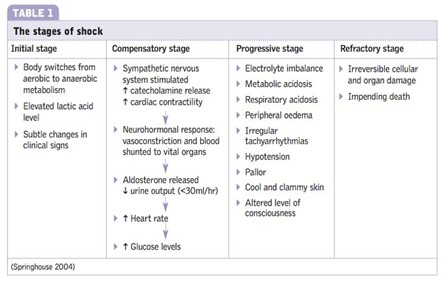The emergency department nurse evaluates that fluid resuscitation for a 70 kg patient in shock is effective by finding which one of the following?
The patient's mean arterial pressure (MAP) is 50 mm Hg.
The patient's GCS score is 9.
The patient's urine output has been 35 ml over the last hour.
The patient's hemoglobin is within normal limits.
The Correct Answer is C
Urine output is an essential indicator of renal perfusion and overall fluid status. In a patient in shock, maintaining an adequate urine output is a crucial goal of fluid resuscitation. A urine output of 0.5 to 1 mL/kg/hour is generally considered adequate in adults. The given value of 35 ml over the last hour suggests that the patient is producing urine, which indicates that fluid resuscitation is effective in restoring perfusion to the kidneys.
A. The patient's mean arterial pressure (MAP) is 50 mm Hg in (option A) is incorrect because While mean arterial pressure is an important hemodynamic parameter, a single value alone may not provide a comprehensive assessment of the patient's response to fluid resuscitation.
B. The patient's GCS score is 9 in (option B) is incorrect because The Glasgow Coma Scale (GCS) assesses the level of consciousness and neurological function but does not directly reflect fluid resuscitation effectiveness.
D. The patient's hemoglobin is within normal limits: (option D) is incorrect because Haemoglobin levels are important for assessing oxygen-carrying capacity but do not directly indicate the effectiveness of fluid resuscitation.
Therefore, the nurse can evaluate that fluid resuscitation for a 70 kg patient in shock is effective by observing a urine output of 35 ml over the last hour.
Nursing Test Bank
Naxlex Comprehensive Predictor Exams
Related Questions
Correct Answer is D
Explanation
In the compensatory stage of shock, the body initiates various mechanisms to maintain perfusion to vital organs and restore homeostasis. Activation of the renin-angiotensin system is one of the compensatory responses. The decreased blood flow and oxygen delivery to the kidneys stimulate the release of renin from the kidneys. Renin acts on angiotensinogen, converting it into angiotensin I, which is further converted to angiotensin II by the action of angiotensin-converting enzyme (ACE). Angiotensin II is a potent vasoconstrictor and also stimulates the release of aldosterone, leading to sodium and water retention. These mechanisms aim to increase blood pressure and cardiac output and restore fluid balance.
A. The initial stage of shock in (option A) is incorrect because it is characterized by inadequate tissue perfusion and the activation of various compensatory mechanisms, including the release of stress hormones. However, the renin-angiotensin system is not specifically mentioned as activated in this stage.
B. The progressive stage of shock in (option B) is incorrect because it occurs when compensatory mechanisms fail to maintain adequate perfusion, leading to worsening hypoperfusion and organ dysfunction. The renin-angiotensin system continues to be activated during this stage, but it is primarily associated with the compensatory stage.
C. The refractory stage of shock in (option C) is incorrect because it is the stage of severe and prolonged hypoperfusion, where organ failure becomes irreversible. The renin-angiotensin system may still be activated, but it is not the primary focus of this stage.
Therefore, the activation of the renin-angiotensin system occurs during the compensatory stage of shock.

Correct Answer is C
Explanation
The nurse should listen over both lung fields to ensure that air entry is present bilaterally, indicating that the tube is correctly positioned in the trachea. This comes after observing chest movements.
B. Using an end-tidal CO2 monitor to check for placement in the trachea in (option B) is incorrect because End-tidal CO2 monitoring can provide confirmation of correct tube placement in the trachea by detecting exhaled CO2 levels. However, it requires additional equipment and setup, which may not be readily available at the bedside or immediately accessible.
C. Observing the chest for symmetrical movement with ventilation is the initial action after placing an endotracheal tube.
D. Obtaining a portable chest radiograph to check tube placement (option D) is incorrect because Chest radiographs are commonly used to confirm endotracheal tube placement, especially for long-term confirmation or if there are concerns about placement. However, obtaining a portable chest radiograph may involve delays and is not the initial action to be taken for immediate verification.
Therefore, the best initial action by the nurse to verify the correct placement of an endotracheal tube (ET) after insertion is to auscultate for the presence of bilateral breath sounds.

Whether you are a student looking to ace your exams or a practicing nurse seeking to enhance your expertise , our nursing education contents will empower you with the confidence and competence to make a difference in the lives of patients and become a respected leader in the healthcare field.
Visit Naxlex, invest in your future and unlock endless possibilities with our unparalleled nursing education contents today
Report Wrong Answer on the Current Question
Do you disagree with the answer? If yes, what is your expected answer? Explain.
Kindly be descriptive with the issue you are facing.
